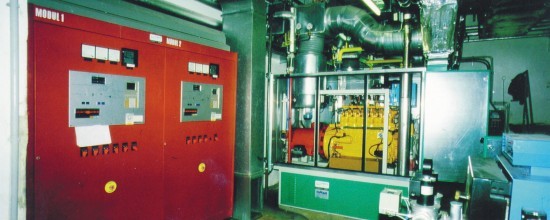
Combined heat and power station (CHP)

Combined heat and power station (CHP)
The ufaFabrik’s first combined heat and power stations (CHPs) were set up in the early 1980s. An old truck was repurposed and rebuild as a CHP to generate electricity and heat. The diesel engine powered a generator and the energy that was generated by the cooling water and exhaust gas was used for general heating and for heating the water by heat exchangers that were specifically built for this purpose.
At this time, a flue gas cleaning system reduced the harmful substances in the exhaust gas. The relatively primitive “Mao-Diesel” generated about 50 kilowatt of electricity and around 100 kilowatt of heat per…and therefore already made better use of the energy from the fuel than coal power plants. The main advantage of a CHP is that is much easier to adjust the amount of power it generates to what is required and that the distance it travels is very short. The loss of energy is thereby also significantly reduced in comparison to larger scale power plants.
The “Mao-Diesel” was replaced by a computer controlled heat and power system with an even higher efficiency level in 1994. Its core consists of two six-cylinder engines and two specialty generators that together generate about 88 kilowatt of electricity and 190 kilowatt of heat per….
It is fueled by natural gas, which emits significantly fewer harmful substances than coal or fuel oil. The exhaust gas from the engines is cleaned by a catalyst and a heat exchanger repurposes the waste heat. Most of the electricity that is generated this way is used directly on the ufaFabrik premises.
Part of the electricity is channeled into the Berlin power supply system (BEWAG – Berliner Städtische Elektrizitätswerke A. G.) for a small profit per kilowatt-hour. The conventionally generated electricity from the power supply system is significantly more expensive. The ufaFabrik only uses conventional electricity when there is an acute shortage, for instance when there are several events with extensive stage lighting requirements taking place at the same time. To reduce the loss of heat, all the ufaFabrik buildings are connected to the two CHPs through an up to date and well isolated piping system.
The CHPs generated about 300.000 kWh (per…) which covered 75% of the ufaFabrik’s required electricity. Only around 100.000 kWh were additionally provided by the Berlin power supply system. These numbers show the difference between conventionally generated electricity and using an alternative like the CHPs in regards to the effects on the environment. In October 2003, the ufaFabrik also changed the supplier of electricity and since then only green electricity, generated from renewable energy is used.
